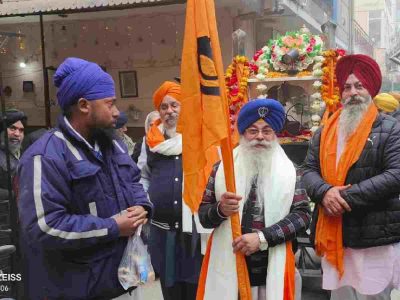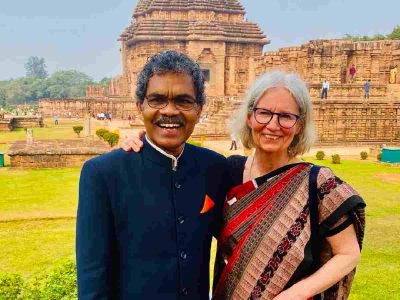Book Review: It was perhaps the strongest batting line up India ever had. And what a dream ‘Famous Five’ they were — Sachin Tendulkar, Rahul Dravid, VVS Laxman, Sourav Ganguly, and Virender Sehwag, batting one after the other. When they featured in the Indian Test XI, the opposition feared them. Even if only two of them clicked in the same innings or match, India would invariably find itself in a comfortable position.
The first of the five to arrive on the scene was Tendulkar, who debuted as a 16-year old batting prodigy in 1989. Interestingly, he was also the last of them to bid farewell to international cricket in 2013, after representing India successfully for 24 years. Together, they played for India for seven years, between 2001 and 2008, conjuring up many memorable wins and thrilling millions of cricket fans. In One Day Internationals (ODIs), they played together 22 times between 2001 and 2004, often forming a formidable top five in the batting order.
Also read: Delhi: A puppetry festival bringing global traditions to life
Individually, all five went on to play over 100 Tests, and four of them played at least 250 ODIs. The lone exception was Laxman, who played 86 ODIs. Their exploits have now been compiled into a book, Fab Five: The Pandavas of India’s Batting, by Aditya Bhushan, who likens each of them to the five Pandava brothers of Hindu mythology. They are Yudhisthir (Ganguly), Bheem (Sehwag), Arjun (Tendulkar), Nakul (Laxman), and Sahadev (Dravid). The book, structured into six chapters, is backed by detailed statistics, chronicling the era when these five players formed the backbone of Indian batting in 64 international matches.
Former India captain Dilip Vengsarkar, who has written the foreword, lauds the uniqueness of each player. “They all had their unique styles — Sachin was perfection personified, Sourav was a true leader, Laxman had amazing wristwork, Rahul’s batting was straight from the manual, and Sehwag breathed new life into the game. But what stood out for me was the pride they had for the country,” he writes.
Tendulkar echoes similar sentiments in the book: “We were all different players and had our individual strengths. We used them to complement each other and contribute to the team. We never tried to match each other, and that helped because our collective goal was the same—winning matches for India.”
Batting together
The ‘Fab Five’ first played together in an ODI against Australia on March 25, 2001, in Bangalore, and later that year in Test cricket. On both occasions, Sehwag made an immediate impact. In the Bangalore ODI, he smashed a 54-ball 58 and took three wickets for 59 runs with his part time off-spin, earning the Man of the Match award. The five went on to feature in 22 ODIs over the next three years. India won 11 of those matches and lost 11, indicating that their collective presence was more impactful in Test cricket than in ODIs. Their final ODI appearance together was at Eden Gardens on November 13, 2004, where despite Sehwag’s 53, Pakistan triumphed.
In Test cricket, they played together in 42 matches, of which India won 14, lost 11, and drew 17. Of these, 17 Tests were played at home, where India won six, lost one, and drew the rest. In the 25 overseas Tests, the team won eight, lost 10, and drew seven. The first time the five played together in a Test was in Bloemfontein, South Africa, in November 2001, the match in which Sehwag scored a sensational century on debut. Despite centuries from him and Tendulkar in the first innings, India lost.
While their presence did not always guarantee victory, their individual performances and partnerships were often monumental. However, the role of bowlers, the quality of opposition, venue conditions, and spectator support were also crucial factors in determining match outcomes.
Impactful Sehwag
Among the five, Delhi-based Sehwag was arguably the most impactful. Though a product of limited-overs cricket, he flourished more in Tests. As an opener, he would demoralise opposition bowlers before they could settle, providing a launchpad for the middle order. This often translated into victories for India.
Perhaps Sehwag’s most memorable knock was his 68-ball 83 against England in Chennai in December 2008. His blistering innings, combined with a 117 run opening stand with Gautam Gambhir (66), set up India’s successful chase of 387 runs. Tendulkar’s unbeaten century sealed a historic six-wicket win, but Sehwag’s explosive innings was key, earning him the Man of the Match award.
Sehwag was also the first Indian to score a triple century in Tests, achieving the feat against Pakistan in Multan in 2004. He later bettered his own record with a brilliant 319 against South Africa in 2008. Interestingly, Ganguly was absent in both the Multan and Chennai Tests, just as Sehwag was missing during India’s legendary victory over Australia in the Kolkata Test of 2001. In that match, Laxman (281, an Indian record) and Dravid (180), along with Harbhajan Singh’s bowling heroics, orchestrated a remarkable turnaround under Ganguly’s captaincy.
Recalling the Kolkata victory, Tendulkar notes, “We were pushed badly into a corner in the second Test of the series. The fourth day was pivotal. Both Rahul and Laxman were brilliant that day, scoring at a very good pace, which put us in a commanding position. At that point, we could see light at the end of the tunnel. We realised that if we had a good session on Day Five, victory was possible.”
“Harbhajan was bowling really well but lacked support from the other end since Anil [Kumble] wasn’t there. I had a supporting role to play that day and am glad to have contributed with three important wickets. All in all, it was a great Test match and one that I remember very fondly,” Tendulkar adds. “Harbhajan was bowling really well but lacked support from the other end since Anil [Kumble] wasn’t there. I had a supporting role to play that day and am glad to have contributed with three important wickets. All in all, it was a great Test match and one that I remember very fondly,” Tendulkar adds.
Those who also ran
The book also highlights an important event preceding the Fab Five’s dominance—the 2000 Hansie Cronje match-fixing scandal, which led to bans on some Indian players and a shake-up in leadership. This incident indirectly paved the way for Ganguly’s appointment as captain, under whom a new generation of Indian cricketers thrived. Ganguly aggressively backed young talents like Sehwag, Harbhajan, Yuvraj Singh, Zaheer Khan, and Ashish Nehra. He called Sehwag the most talented cricketer he had seen and promoted him to the opening slot with great success.
Also read: Dhammar Utsav: Breathing new life into a fading Holi tradition
The book also features a chapter on players who were in contention for a place in the team but never quite made it. Among them is Amol Muzumdar (Mumbai), who set a world record with 260 not out on his first-class debut in 1994 but never played for India. Other players mentioned include S Badrinath (Tamil Nadu), Wasim Jaffer (Mumbai and Vidarbha), who played 31 Tests, and Mithun Minhas (Delhi and Jammu and Kashmir), a surprise inclusion in this section.
The 217-page book is published by the Mumbai-based Global Cricket School and is priced at Rs 799.
(The writer is a senior journalist based in Delhi and has covered sports for over three decades)





